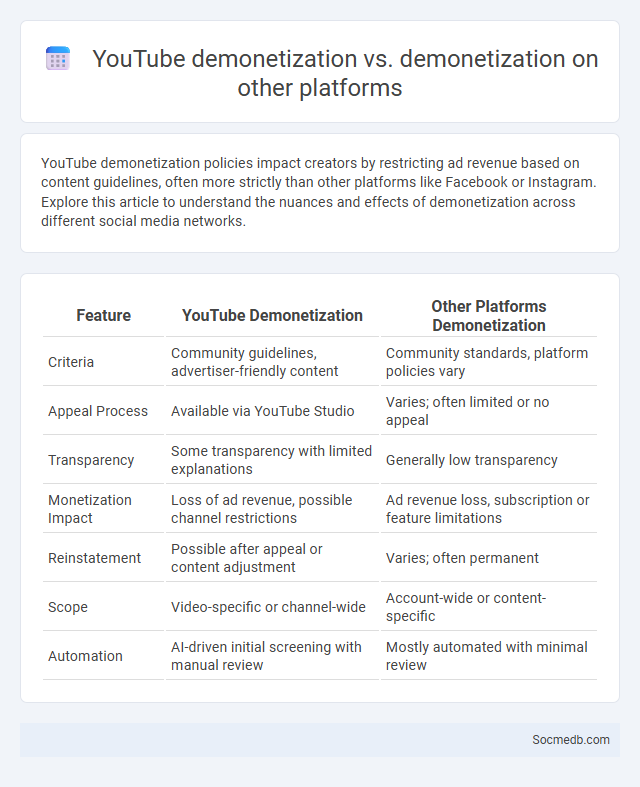
Photo illustration: YouTube demonetization vs demonetization on other platforms
YouTube demonetization policies impact creators by restricting ad revenue based on content guidelines, often more strictly than other platforms like Facebook or Instagram. Explore this article to understand the nuances and effects of demonetization across different social media networks.
Table of Comparison
| Feature | YouTube Demonetization | Other Platforms Demonetization |
|---|---|---|
| Criteria | Community guidelines, advertiser-friendly content | Community standards, platform policies vary |
| Appeal Process | Available via YouTube Studio | Varies; often limited or no appeal |
| Transparency | Some transparency with limited explanations | Generally low transparency |
| Monetization Impact | Loss of ad revenue, possible channel restrictions | Ad revenue loss, subscription or feature limitations |
| Reinstatement | Possible after appeal or content adjustment | Varies; often permanent |
| Scope | Video-specific or channel-wide | Account-wide or content-specific |
| Automation | AI-driven initial screening with manual review | Mostly automated with minimal review |
Understanding Demonetization: Definition and Context
Demonetization on social media refers to the restriction or removal of a creator's ability to earn revenue from their content due to violations of platform policies or changing advertiser guidelines. Understanding the specific reasons behind your content being demonetized helps you adapt strategies to comply with community standards and regain monetization privileges. This process impacts content visibility and creator income, making it essential to stay informed about each platform's evolving rules and enforcement mechanisms.
The Rise of Demonetization Policies Online
The rise of demonetization policies on social media platforms such as YouTube, Facebook, and TikTok has dramatically reshaped content creation by restricting ad revenue for videos deemed inappropriate or controversial. These policies often rely on artificial intelligence algorithms to identify and limit monetization on content related to sensitive topics, impacting creators' earnings and content strategies. As platforms balance advertiser demands with creator freedom, demonetization continues to influence the digital economy and online discourse.
YouTube Demonetization: How It Works
YouTube demonetization occurs when videos fail to meet the platform's advertiser-friendly guidelines, affecting creators' revenue streams. Factors such as inappropriate content, excessive profanity, or sensitive topics trigger automatic or manual review leading to limited or no ads. Understanding YouTube's strict policies helps creators optimize content for sustained monetization and audience growth.
Common Reasons for YouTube Demonetization
YouTube demonetization commonly occurs due to violations of community guidelines, such as inappropriate content, copyright infringement, or harmful misinformation. Videos containing explicit language, violence, or adult themes also risk losing monetization status. Consistent breaches of advertiser-friendly content policies significantly contribute to channel demonetization.
Demonetization Across Other Social Media Platforms
Demonetization on social media platforms like YouTube, Facebook, and Instagram significantly impacts content creators' revenue streams and engagement strategies. Algorithms and policy changes targeting advertiser-friendly content often result in reduced earnings and limited reach for You, especially when controversial or sensitive topics are involved. Understanding these platform-specific demonetization criteria helps maximize Your content's visibility and monetization potential across diverse channels.
Comparing Demonetization Criteria: YouTube vs. Others
YouTube demonetization criteria primarily target content that violates community guidelines, including hate speech, violence, and misinformation, with strict enforcement policies and automated detection systems. Other platforms like Facebook and Instagram emphasize advertiser-friendly content and user safety but tend to apply broader, less transparent moderation rules. The clear distinction lies in YouTube's algorithm-driven monetization thresholds versus other platforms' engagement and content quality metrics.
Impact of Demonetization on Content Creators
Demonetization significantly impacted content creators by reducing their revenue streams on platforms like YouTube and Facebook, leading to financial instability for many independent artists and influencers. The shift to stricter ad policies and content guidelines forced creators to adapt their material to meet new monetization criteria, often narrowing creative freedom. As a result, many creators diversified income sources through sponsorships, merchandise, and crowdfunding to sustain their digital presence.
Strategies to Prevent Demonetization
Creating consistent, original content aligned with platform guidelines reduces the risk of demonetization on social media. You should avoid copyright infringement and use appropriate metadata to enhance content discoverability and maintain monetization eligibility. Engaging with your audience through transparent communication boosts trust, safeguarding your channel's revenue streams.
Monetization Alternatives After Demonetization
Creators can explore monetization alternatives post-demonetization through diversified revenue streams such as brand partnerships, affiliate marketing, and crowdfunding platforms like Patreon. Offering exclusive content via subscription models or merchandise sales also generates sustainable income while maintaining audience engagement. Leveraging emerging platforms with less restrictive monetization policies provides additional opportunities to capitalize on social media presence.
The Future of Demonetization in the Creator Economy
The future of demonetization in the creator economy is shaped by increasing platform regulation and evolving content monetization models that prioritize quality and compliance. Emerging technologies like blockchain and decentralized finance (DeFi) offer creators alternative revenue streams beyond traditional ad-based monetization. Platforms are likely to implement more transparent and adaptive monetization policies to balance user experience with sustainable income for creators.
 socmedb.com
socmedb.com